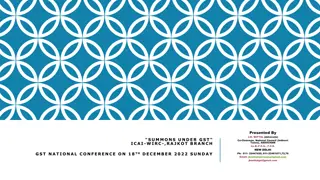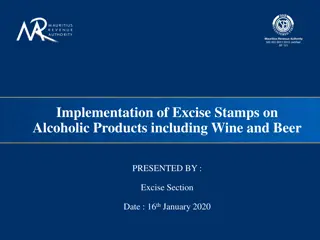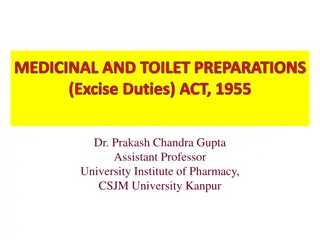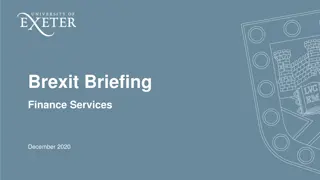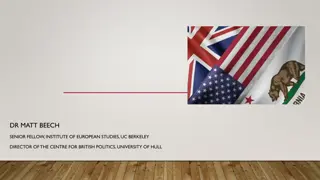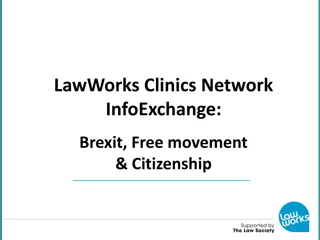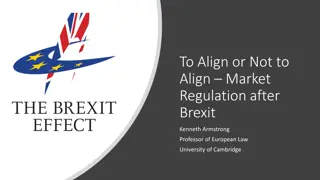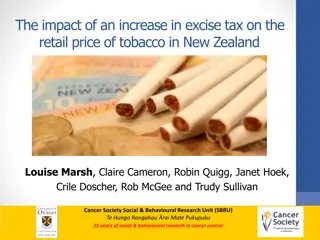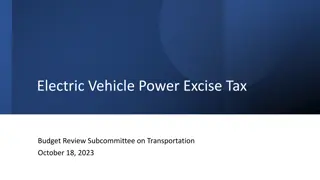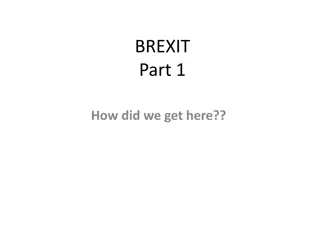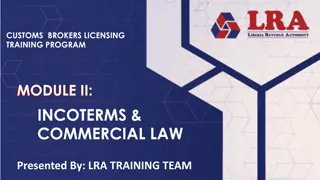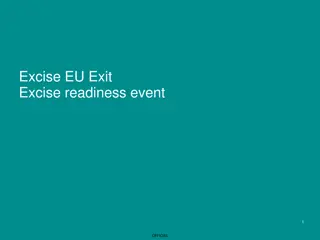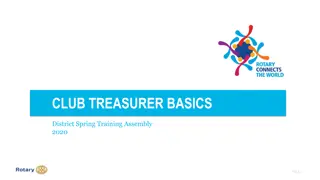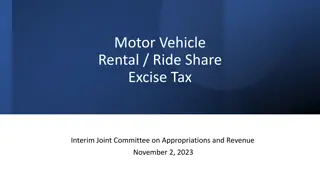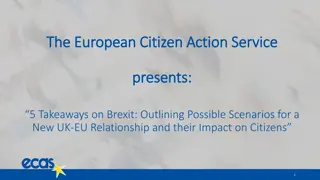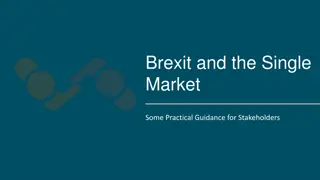Incoterms and Excise Brexit Planning Guidance
This guidance by Brightfinch Ltd focuses on Incoterms and excise Brexit planning for UK companies procuring wine from EU member states. It outlines the use of appropriate Incoterms, customs obligations, and the importance of establishing contracts between buyers and sellers. The recommended Incoterm, Free Carrier (FCA), is explained in detail for post-Brexit transitions, emphasizing the benefits for both EU suppliers and UK importers.
Download Presentation

Please find below an Image/Link to download the presentation.
The content on the website is provided AS IS for your information and personal use only. It may not be sold, licensed, or shared on other websites without obtaining consent from the author.If you encounter any issues during the download, it is possible that the publisher has removed the file from their server.
You are allowed to download the files provided on this website for personal or commercial use, subject to the condition that they are used lawfully. All files are the property of their respective owners.
The content on the website is provided AS IS for your information and personal use only. It may not be sold, licensed, or shared on other websites without obtaining consent from the author.
E N D
Presentation Transcript
INCOTERMS & EXCISE B R E X I T P L A N N I N G B R E X I T P L A N N I N G
This guidance has been developed In collaboration with Brightfinch Ltd Brightfinch specialise in customs and international trade compliance and authorisations, providing consultancy and training for businesses. Brightfinch pride themselves in their practical, hands on approach to supporting businesses A B O U T B R I G H T F I N C H We are proud to work closely with a number of trade organisations and bodies such as WSTA, Chambers of Commerce and IOE&IT For further information, visit www.brightfinch.com
INTRODUCTION The guidance focuses on three common scenarios where UK companies procure wine from EU member states. The guidance outlines what we feel are the most appropriate Incoterms to use in these scenarios, with a particular focus on the customs obligations associated with each. The International Chamber of Commerce produces the Incoterms rules, which are revised every ten years. The current version is Incoterms 2020. The specify risks, obligations and costs between the buyer and the seller under eleven different trade scenarios. The guidance we provide here is aligned with the Incoterms 2020 format, showing the seller s responsibilities in blue, and the buyer s responsibilities in orange. We have expanded on the ICC Incoterms 2020 diagrams to also highlight EMCS responsibilities and specific terms relating to UK EU trade. The buyer and seller can choose to undertake these responsibilities themselves, or contract these out to third parties such as hauliers, forwarders and clearing agents. Incoterms are no substitute for a contract, and we would always recommend a contract is established between the buyer and seller which includes incoterms in addition to other considerations relating to quality, payment and other specifics. Furthermore, in the majority of Incoterms, the seller and buyer are obliged to assist each other with clearance formalities even when the other is responsible. This will be of vital importance with future trade between the UK and EU, where communication lines will need to be clarified to ensue a driver crossing the UK EU border has all the references required on both sides.
FREE CARRIER (FCA) RATIONALE In all scenarios FCA appears to be the most appropriate Incoterm for the management of collections of excise suspended goods from Europe post-Brexit transition period, for the following reasons: The EU supplier will have EMCS access and the guarantee in place to raise the movement to the port of exit or other excise approved location such as a consolidation centre. The EU supplier will be shown on the export entry as the exporter of record, ensuring they receive proof of export which is necessary to zero-VAT rate the sale. The UK importer therefore is not required to register for an EU EORI, VAT number or company registration. The UK importer retains full control of the UK import declaration and subsequent EMCS movement. FCA still allows for the wine or other alcoholic beverage to be collected from the suppliers premises, or any other agreed location within the EU. As the risk does not transfer from the seller to the buyer until the goods have been either collected from the sellers premises or delivered to another agreed location by the seller, this model would also be appropriate for en primeur wine purchases, although we would recommend outlining the agreed storage and collection periods within a contract.
S C E N A R I O 1 U K D I S T R I B U T O R C O L L E C T S W I N E F R O M S I N G L E E U S O U R C E , T O S T O R E I N U K A N D S E L L O N The UK distributor sends vehicle to collect wine from the EU source The EU supplier arranges the EU EMCS movement from their premises to the port of exit The EU supplier either arranges the customs export entry, or allows the UK distributor to make these arrangements in their name and against their EU EORI. The export entry will usually need to be handled by an excise approved consignee (or EU equivalent) who can discharge the EMCS movement. The UK distributor arranges the customs import entry (using their UK EORI) and onwards UK EMCS domestic movement. The import entry will need to be handled by an excise approved consignor who can raise the EMCS movement from the UK port to the approved UK premises. The guarantee can be provided by either the agent or the UK distributor. Suppliers Premises Suppliers Premises or other agreed EU or other agreed EU collection point collection point EU Border EU Border UK Border UK Border COSTS COSTS FCA FCA RISKS RISKS EMCS EMCS Import Entry via approved consignor Export Entry via approved consignee
S C E N A R I O 2 U K D I S T R I B U T O R C O L L E C T S W I N E F R O M M U L T I P L E E U S O U R C E S , C O N S O L I D A T E S I N T H E E U T H E N I M P O R T S T O S T O R E I N U K A N D S E L L O N The UK distributor sends vehicle to collect wine from the EU sources and moves the consignments to an excise approved consolidation facility (FCA sellers premises), or alternatively the EU source delivers into the consolidation facility (FCA named delivery point). The EU supplier arranges the EU EMCS movement from their premises to the approved consolidation facility as a domestic EMCS movement. The EU consolidator can arrange export clearance on behalf of the EU sellers to ensure they receive proof of export, and also the onward EU EMCS movement to the port of exit. The UK distributor arranges UK import clearance and onwards UK EMCS movement. EU Consolidation EU Consolidation Centre Centre Suppliers Premises Suppliers Premises or other agreed EU or other agreed EU collection point collection point MULTIPLE EU MULTIPLE EU SOURCES SOURCES EU Border EU Border UK Border UK Border COSTS COSTS FCA FCA RISKS RISKS EMCS EMCS Using invoices from EU suppliers to UK Using invoices from EU suppliers to UK importer Export Entry & EMCS to port via approved consignee Import Entry via approved consignor importer
S C E N A R I O 3 U K A G E N T S O U R C E S W I N E F R O M E U S U P P L I E R ( S ) A N D S U B - S E L L S T O U K C U S T O M E R S . C U S T O M E R S E N D S O W N V E H I C L E T O C O L L E C T A N D B R I N G T O T H E U K The UK agent receives invoices from the EU suppliers. The UK agent then raises an invoice to their UK customer. The UK customer sends their own vehicle to collect goods from the EU supplier. The EU supplier arranges the EU EMCS movement from their premises to the port of exit, alongside the export entry and provides reference numbers to the driver. The UK agent or the UK customer arranges UK import clearance and onwards UK EMCS movement Suppliers Premises Suppliers Premises or other agreed EU or other agreed EU collection point collection point EU Border EU Border UK Border UK Border COSTS COSTS FCA FCA RISKS RISKS EMCS EMCS Using invoice from EU supplier to UK Import Entry & EMCS via approved consignor Export Entry & EMCS via approved consignee Using invoice from UK agent to UK customer agent
FREE CARRIER (FCA) RULES The Incoterm should be shown on commercial documentation between the buyer and seller as follows: FCA (insert named place of delivery) 2020 Named place of delivery is defined as follows: Sellers premises: state the location of the EU supplier where the supplier must load the goods to the collecting vehicle Other agreed location: state the location such as a consolidation warehouse where supplier must deliver to and make goods available for unloading The named place of delivery is where the risk transfers from the seller to the buyer, and therefore the UK company should ensure their insurance covers the movement from this stage. The named point should be as precise as possible (e.g. postcode) rather than town name in order to avoid misunderstandings. FCA is a multimodal term, making it suitable for road, sea, air or rail movements, or a combination of these modes
ALTERNATIVES If the EU supplier wanted to deliver the goods to a UK address, then DAP (UK destination) would be most appropriate. COSTS COSTS DAP DAP RISKS RISKS EMCS EMCS Import Entry via approved consignor Export Entry via approved consignee In this scenario, the EU supplier would still be the exporter in the EU, and the UK company would be the importer in the UK. The place of delivery under DAP could be the UK companies premises or any other chosen destination point in the UK. The main difference is that the EU supplier now takes on the risk and cost of the movement until it arrives at the agreed UK destination. However, note that if the UK company fail to arrange import clearance, then the costs and risks resulting from delays will sit with the UK company and not the EU company.
POINTS TO NOTE There will be varying (often limited) levels of Incoterms knowledge across Europe. A supplier unfamiliar with FCA and familiar with EXW or Ex-cellar may be reluctant to change terms initially. More experienced European suppliers may insist on additional export entry procedures to ensure they can control the EMCS discharge and obtain proof of export. This would likely entail appointing the export agent, or liaising directly with the EU agent appointed by the UK importer. Some larger businesses with registrations in multiple countries may choose to operate a different model such as DDP but we do not expect this to be relevant to most businesses. Although the Union Customs Code is the customs legislation covering EU member states, the implementation of this code differs between the individual customs authorities, so minor adaptations in procedures may be required between these different member states. EMCS is an EU wide scheme, and the UK access for the rest of the EU will be severed at the end of 2020. EMCS access for UK businesses will only be applicable to UK domestic movements under suspension. Although EMCS will remain in use by the remaining 27 EU member states as it does today, Excise law differs between EU member states and is national law (rather than EU wide) although does have linkages with the UCC. The exact agents to be used on EU and UK side, and any EMCS or customs entry specifics should be discussed between The exact agents to be used on EU and UK side, and any EMCS or customs entry specifics should be discussed between the buyer and seller, and outlined in a contract. In some situations it may be advantageous for the same agent to be the buyer and seller, and outlined in a contract. In some situations it may be advantageous for the same agent to be appointed by both buyer and seller to streamline the clearance process. appointed by both buyer and seller to streamline the clearance process.
Incoterm Incoterm Status Status Rationale Rationale EXW Ruled out Requires UK company to become registered in EU* FCA Primary solution Gives exporter and importer the appropriate controls to raise customs and EMCS declarations in their countries where they already hold approvals required CPT Ruled out Supplier doesn t usually arrange transport without being in control of it CIP Ruled out As above DAP Secondary solution When EU supplier delivers to the UK DPU Ruled out Not normal in industry to require deliveries to be unloaded by supplier DDP Ruled out Would require EU company to become registered in the UK* *By registered in the EU / UK this would relate to EORI, VAT & business to obtain EMCS access and hold a guarantee with customs. It is possible (although unlikely) some clearing agents holding registered consignee / consignor could raise EMCS movements on behalf of the UK or EU company to avoid registration, but there may still be issues with VAT.



